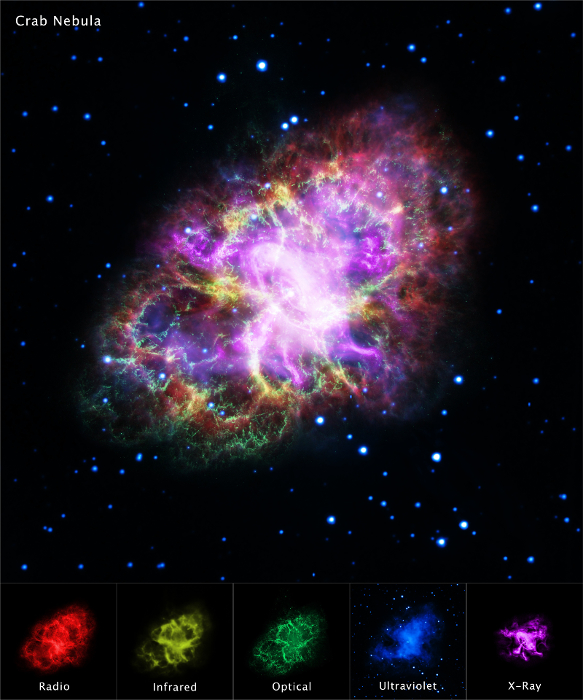
 Credit: Credit: G. Dubner (IAFE, CONICET-University of Buenos Aires) et al.; NRAO/AUI/NSF; A. Loll et al.; T. Temim et al.; F. Seward et al.; Chandra/CXC; Spitzer/JPL-Caltech; XMM-Newton/ESA; and Hubble/STScI
Credit: Credit: G. Dubner (IAFE, CONICET-University of Buenos Aires) et al.; NRAO/AUI/NSF; A. Loll et al.; T. Temim et al.; F. Seward et al.; Chandra/CXC; Spitzer/JPL-Caltech; XMM-Newton/ESA; and Hubble/STScI
Catching a New Crab
One of the most spectacular astronomical sights is the remnant of a star that famously exploded on July 4, 1054, and witnessed in near-real time from earth (only delayed by the light-travel time of about 6,500 years). This explosion created the Crab Nebula, Messier 1, perhaps the most studied space object outside the solar system. The Crab Nebula is a brightly glowing cloud of hot gas, fast-moving electrons and atomic nuclei, surrounding its beating heart, a pulsar no larger than the city of Washington, DC, yet containing more matter than the Sun, and which rotates at an incredible rate of 30 times per second. The strong magnetic field and rapid rotation of this neutron star produces strong particle beams which generate pulsations from the radio to X-rays and which dramatically interact with the surrounding nebula. The Crab provides a important laboratory to study what happens after massive stars die, and to understand the physics of neutron stars, and even what type of strange matter must exist below the neutron star surface. The Crab, being a bright and relatively nearby source of X-rays, even serves to calibrate modern X-ray satellite observatories. The image above is the best multi-wavelength image of the Crab Nebula, combining radio, infrared, optical, UV and X-ray images. Each image provides clues about different aspects of the physical conditions in the Nebula: hot electrons moving around strong magnetic fields, heated dust, dense knots of gas, and million-degree gas powered by the explosion and stirred up by the strong magnetic field of the central spinning pulsar.
Published: July 10, 2017
<
HEA Dictionary ● Archive
● Search HEAPOW
● Other Languages
● HEAPOW on Facebook
● Download all Images
● Education ● HEAD
>

Each week the HEASARC
brings you new, exciting and beautiful images from X-ray and Gamma ray
astronomy. Check back each week and be sure to check out the HEAPOW archive!
Page Author: Dr. Michael F. Corcoran
Last modified Monday, 26-Feb-2024 17:45:08 EST


